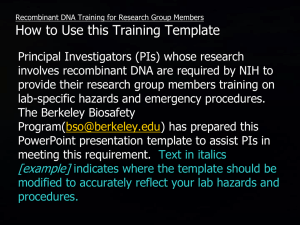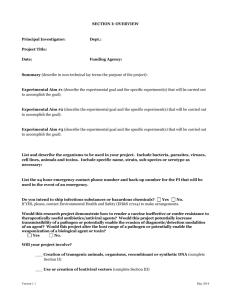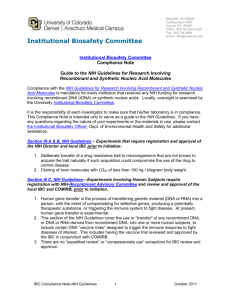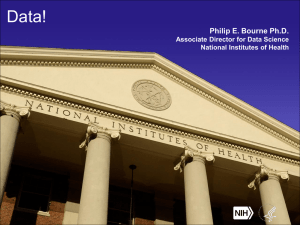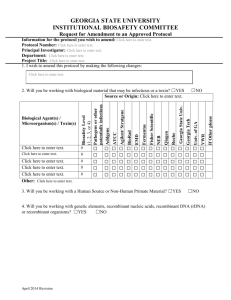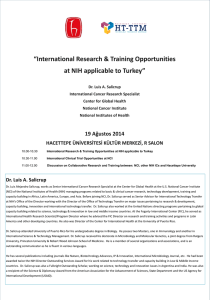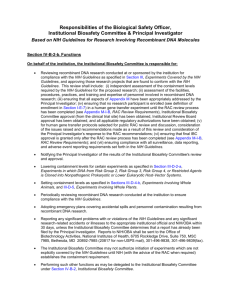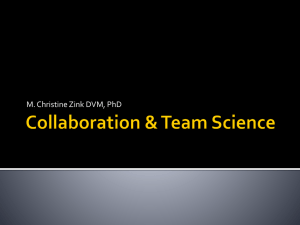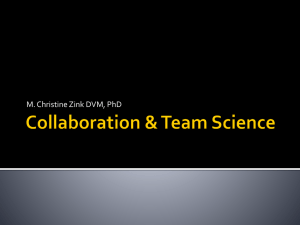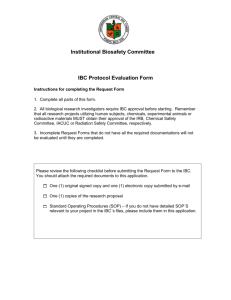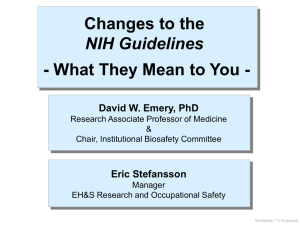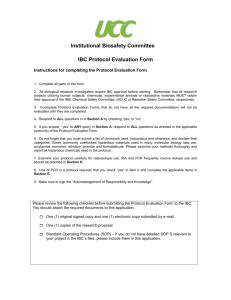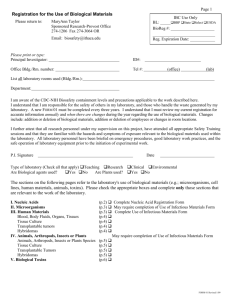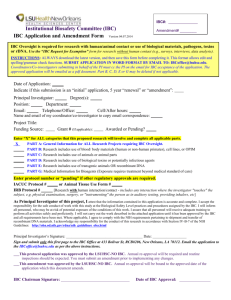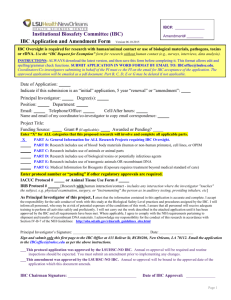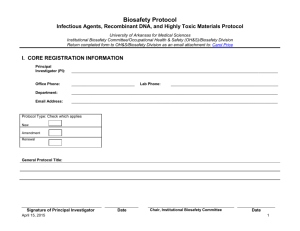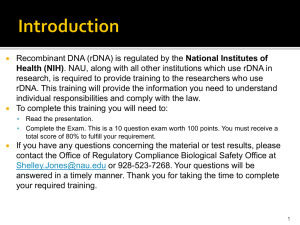BioSafety-`13
advertisement
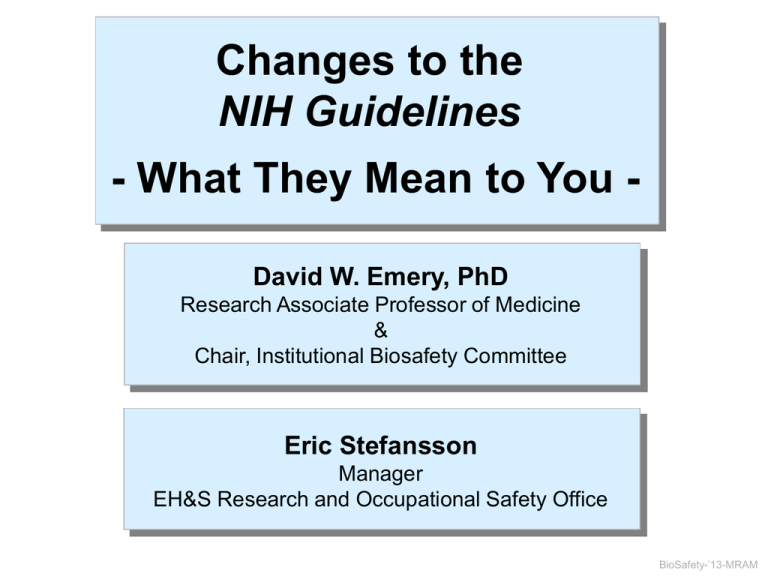
Changes to the NIH Guidelines - What They Mean to You David W. Emery, PhD Research Associate Professor of Medicine & Chair, Institutional Biosafety Committee Eric Stefansson Manager EH&S Research and Occupational Safety Office BioSafety-’13-MRAM Types of Biohazardous Research • Infectious agents - Microorganisms (E. coli → Tuberculosis) - Viruses (AAV → HIV) - All human source materials (including cell lines) • Recombinant DNA - Transfer DNA/RNA to or from microorganisms or any living cells - Transgenic mice - Transgenic plants - Clinical gene therapy trials - Synthetic DNA (PCR, sequencing, etc…) • Select Agents (high security) • Laboratory settings • Live animals • Clinical trials & Field tests BioSafety-’13-MRAM Oversight of Biohazardous Research - a team approach - EH&S Research & Occupational Safety (ROS) Institutional Biosafety Committee Investigator with help from Administrators BioSafety-’13-MRAM EH&S / ROS • Staffed by biosafety professionals • Responsible for administering biosafety programs and monitoring compliance with applicable regulations & policies. • Key Functions: • Facility design and approval authority • Review research protocols and identify hazards • Provide training, consultation, clearances and set OH requirements • Site assessments/inspections • UW Biohazard Safety Manual • Support IBC BioSafety-’13-MRAM Institutional Biosafety Committee • Composed of faculty, staff, and community members • Committee meetings open to public - public trust! • Key Functions: • Review & recommend institutional policies for research involving rDNA and biological agents. • Review individual research proposals for compliance with Federal, State, local, and institutional regulations: - Biosafety containment levels (BSL1, 2, 3) - Adequacy of facilities, SOPs, training • Independent approval authority for specific proposals. • Monitor and assure compliance with the NIH Guidelines BioSafety-’13-MRAM Federal Authority for IBC Institutions receiving funding from the National Institutes of Health must assure that ALL research is carried out in compliance with the NIH Guidelines for Research Involving Recombinant DNA (& Infectious Agents). (http://www4.od.nih.gov/oba/rac/guidelines/guidelines.html) Assurance of compliance is accomplished through the Institutional Biosafety Committee (IBC) in collaboration with the Institutional Health and Safety Departments. (http://www4.od.nih.gov/oba/IBC/IBCrole.htm) BioSafety-’13-MRAM Biosafety Standards Biosafety standards are defined and codified: • • • • • • • • Institution (Administrative Policy, EH&S/RBSO, IBC) NIH Guidelines CDC/NIH BMBL Biosafety in Microbiological and Biomedical Laboratories US Department of Agriculture Select Agent Rule, 42 CFR Part 73 WISHA/WAC Occupational Health & Safety Standards WAC 296-820 Bloodborne Pathogens Standard Seattle Municipal Code Infectious Waste Management BioSafety-’13-MRAM Biosafety Standards Biosafety standards are defined and codified: • • • • • • • • Institution (Administrative Policy, EH&S/RBSO, IBC) NIH Guidelines CDC/NIH BMBL Biosafety in Microbiological and Biomedical Laboratories US Department of Agriculture Select Agent Rule, 42 CFR Part 73 WISHA/WAC Occupational Health & Safety Standards WAC 296-820 Bloodborne Pathogens Standard Seattle Municipal Code Infectious Waste Management BioSafety-’13-MRAM What Changed ? In September 2012 the National Institutes of Health (NIH) Office of Biotechnology Activities (OBA) published final changes to the NIH Guidelines which it deemed necessary to reflect the emerging technologies involving "synthetic DNA"... Prior to these changes, recombinant DNA was defined, in part, as "joining segments of DNA from different sources"; the new rules were necessary to capture the use of recDNA generated by artificial synthesis (synthetic DNA). This precipitated several other changes to NIH Guidelines... BioSafety-’13-MRAM What Changed ? (continued) • Synthetic DNA is treated the same as Recombinant DNA • Recombinant DNA outside of cells remains "exempt" from the NIH Guidelines, with some exceptions • New rules for recDNA prepared in liposomes, other "vehicles" • New definition and rules for "safe" recDNA inside cells • New rules for chemically modified recDNA • New rules for drug resistance genes in pathogenic agents • New rules for synthetic DNA that exists in nature • New rules for clinical gene therapy • New rules for risk assessment • Reconfirm concept that all recDNA is hazardous BioSafety-’13-MRAM What You Need To Do • Ask your investigators to review their research programs to determine if these changes to the NIH Guidelines apply to their research. • If they received Biological Use Authorization during the past three years and they believe their research approval would be impacted by these changes, they will need to submit a Request for Change form no later than February 28. • If they are currently working without an EH&S Biological Use Authorization and they believe their research falls under the amended NIH Guidelines, they will need to submit a BUA application no later than February 28. BioSafety-’13-MRAM What You Need To Do continued... • On the eGC1 "Compliance Questions", be sure to mark "yes" on EHS-1 if the research involves anything with DNA, including synthetic DNA, as well as microorganisms, or human tissue culture (at a minimum). - this will eventually trigger follow-up by OSP and EH&S if the grant is funded, but does NOT currently place a hold on funding like animal and human subject "just in time" approvals. • Be aware that these changes will soon appear in the UW Biosafety Manual and associated documents, as well as the UW Administrative Policy Statement. BioSafety-’13-MRAM Deadlines • All new applications and change forms must be submitted no later than February 28, 2013. • If you miss this due-date, your application my not be reviewed and approved be the end of March 2013 (the due-date set by the NIH). • Please remember that failure to comply with the NIH Guidelines, including properly registering your research, puts your funding, and that of your colleagues, as risk. BioSafety-’13-Outreach References / Contacts • EH&S Research and Occupational Safety office: 206-221-7770, ehsbio@uw.edu • Biological Use Authorization applications: http://www.ehs.washington.edu/forms/rbs/bua.docx http://www.ehs.washington.edu/forms/rbs/buachange.docx • NIH Guidelines: http://oba.od.nih.gov/rdna/nih_guidelines_oba.html • FAQs for changes to the NIH Guidelines: NIH: http://oba.od.nih.gov/oba/faqs/Synthetic_FAQs-Sept-2012.pdf EH&S: http://www.ehs.washington.edu/rbsresplan/rdna.shtm BioSafety-’13-Outreach ? QUESTIONS ? BioSafety-’13-MRAM



